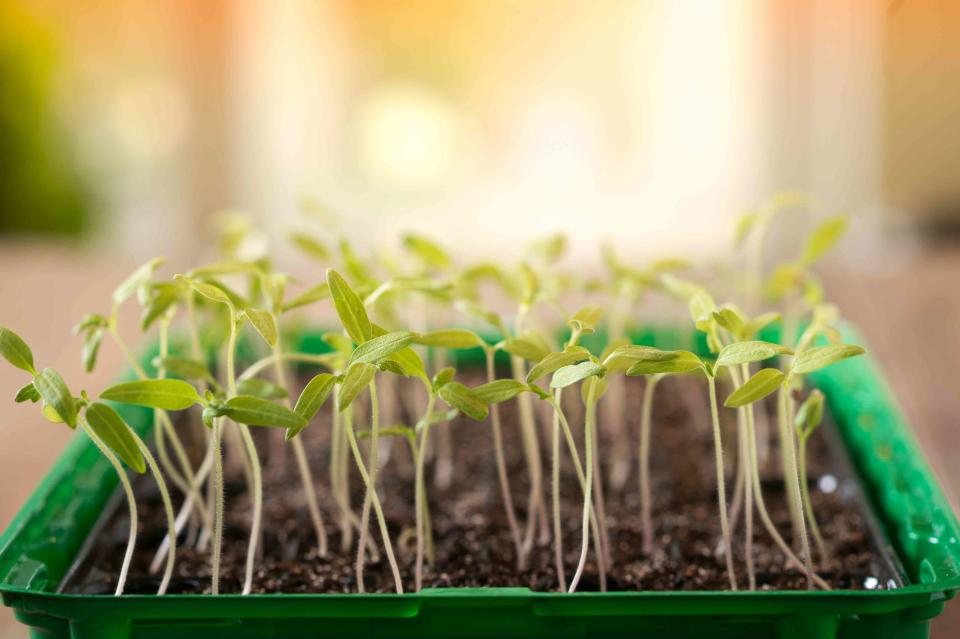How to Fix Leggy Seedlings to Encourage Strong, Healthy Plant Growth
Leggy seedlings can result in delayed fruiting and reduced yield.

MementoImage / Getty Images
Starting seeds indoors is a great way to get a jump on the season, especially if you live in a region with long winters. But doing so requires careful attention to ensure your seedlings have the best chances of success. Inadequate growing conditions, like the wrong amount of light, water, airflow, and spacing, can cause leggy seedlings, which may become too spindly to bear fruit and too weak to survive the stress of the season. To keep this from happening, we spoke to gardening experts who shared their tips for how to prevent leggy seedlings.
Meet the Expert
Larry Stein, Ph.D., Texas A&M AgriLife Extension Service horticulture specialist and professor in the Texas A&M College of Agriculture and Life Sciences Department of Horticultural Sciences.
Carrie Spoonemore, co-creator of Park Seed's From Seed to Spoon app, an app that makes garden planning easier
Related: Our Complete Guide to Starting a Vegetable Garden, from Planting to Harvesting
How to Identify Leggy Seedlings
The term "leggy" refers to plants that are too tall and spindly. You may see leggy seedlings droop because their stalks aren't sturdy enough; they may also have fewer, paler leaves that are light green to yellow in color, says Larry Stein, Ph.D., Texas A&M AgriLife Extension Service horticulture specialist. This often happens to tomatoes, peppers, greens, and common herbs like basil, cilantro, and dill.
Consequences of Leggy Seedlings
A leggy growth habit doesn't mean your plants are dying, but it does suggest a few future problems. "For vegetables, legginess can result in delayed fruiting and reduced yield," says Carrie Spoonemore, co-creator of Park Seed's From Seed to Spoon app. "The plant may struggle to support heavy fruits on weak, elongated stems. Leggy plants often produce fewer blooms because they expend energy on stem elongation rather than flower production."
Additionally, weaker stems are more prone to breaking and are aren't as resistant to damage from pests and diseases, all factors that shorten the lifespan of your plants. "Leggy plants often have less vigor, meaning they are less robust and less capable of recovering from stress or damage," says Spoonemore.
How to Prevent and Fix Leggy Seedlings
Seedlings are most likely to become tall and weak when they are planted in the wrong conditions. Inadequate light is the main cause, as the plant stretches in an effort to find the sun. But overwatering, improper nutrition, indoor climates, and overcrowding can all increase the chances of legginess.
Provide Adequate Light
Ensure your seedlings are in a spot that meets their sun exposure requirements, even if this means using grow lights. "The seedlings can be germinated in less than normal light, but once emerged they need to be exposed to as much light as possible," says Stein. This is true of both sun-loving plants and shade-tolerant ones.
Manage Water and Nutrients
While lack of sunlight is the primary cause of legginess, overwatering can also contribute to the plant's unsteady development. "The plants need oxygen to take up water and nutrients, and, hence, too much water can hinder growth as well," says Dr. Stein. "Use a diluted water-soluble nutrient solution to water the plants every three to five days to make sure they have adequate nutrition."
Related: 10 Indoor and Outdoor Herb Garden Ideas That Guarantee Fresh Basil, Parsley, and More All Year Round
Adjust the Temperature
Too much warmth—or not enough—can also impact a seedling's growth. "The growing conditions need to mimic the regular growing conditions of the plants," says Stein. "Warm season plants need adequate heat, and vice versa for cool season plants, like spinach."
Improve Airflow
Exposure to airflow, like from a fan, encourages seedlings to grow stronger, thicker stems as they sway slightly in the breeze. "This movement mimics the natural environment, making the plants more robust and less prone to becoming leggy," says Spoonemore
Don't Crowd the Seedlings
Seedlings planted too densely battle with each other for sunlight and other resources. "Avoid overcrowding, as this can lead to competition for light and cause legginess," says Spoonemore.
Pinch Your Seedlings
Once your seedlings are at least 3 inches tall, you can pinch them back to encourage bushier growth if you notice that they are leggy, says Spoonemore, adding that you should thin out the weakest plants.
Apply a Balanced Fertilizer
When fertilizing your seedling, be sure to apply a balanced 10-10-10 fertilizer, as to much nitrogen can support legginess, says Spoonemore.
Related: How to Use Tomato Fertilizer for a Better Harvest
Plant Them Deeper
If seedlings become leggy, some types—such as tomatoes, peppers, and brassicas—can be planted deeper to help them develop stronger root systems and sturdier stems, says Spoonemore.
Read the original article on Martha Stewart.

